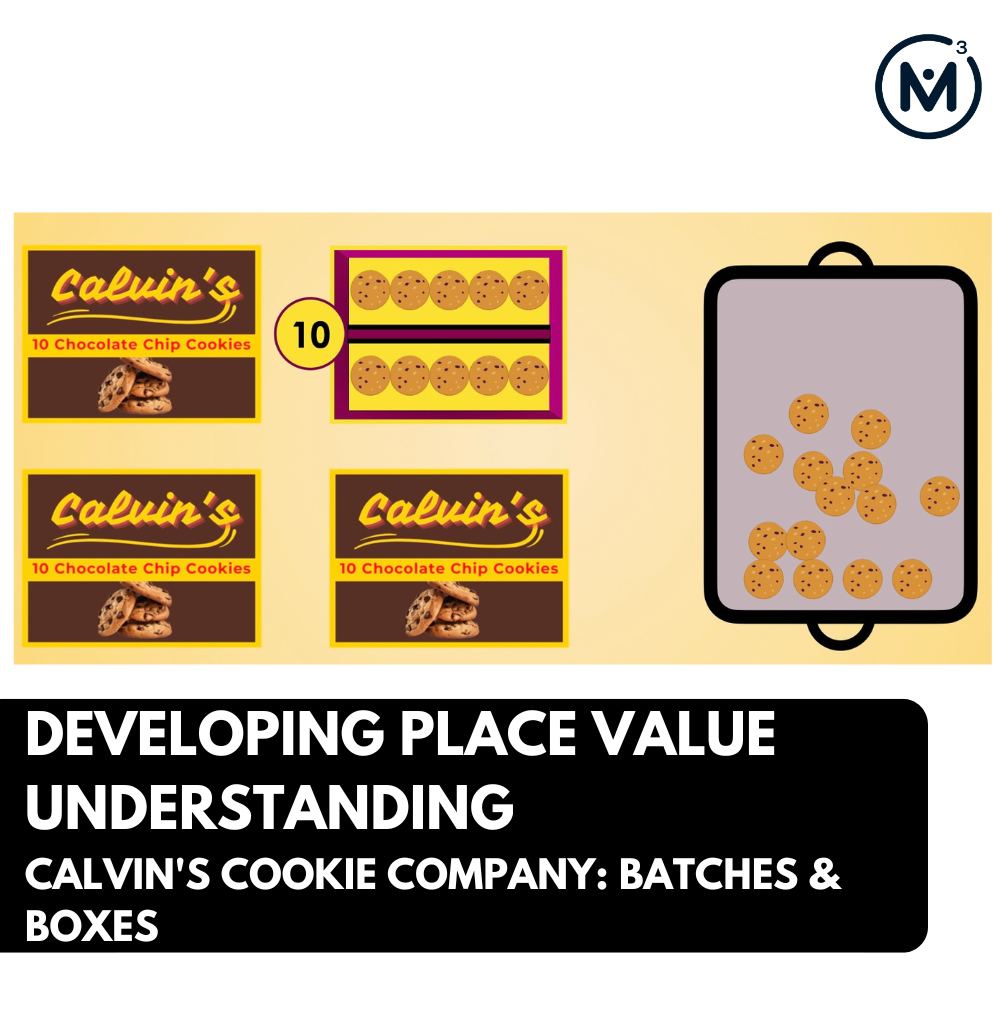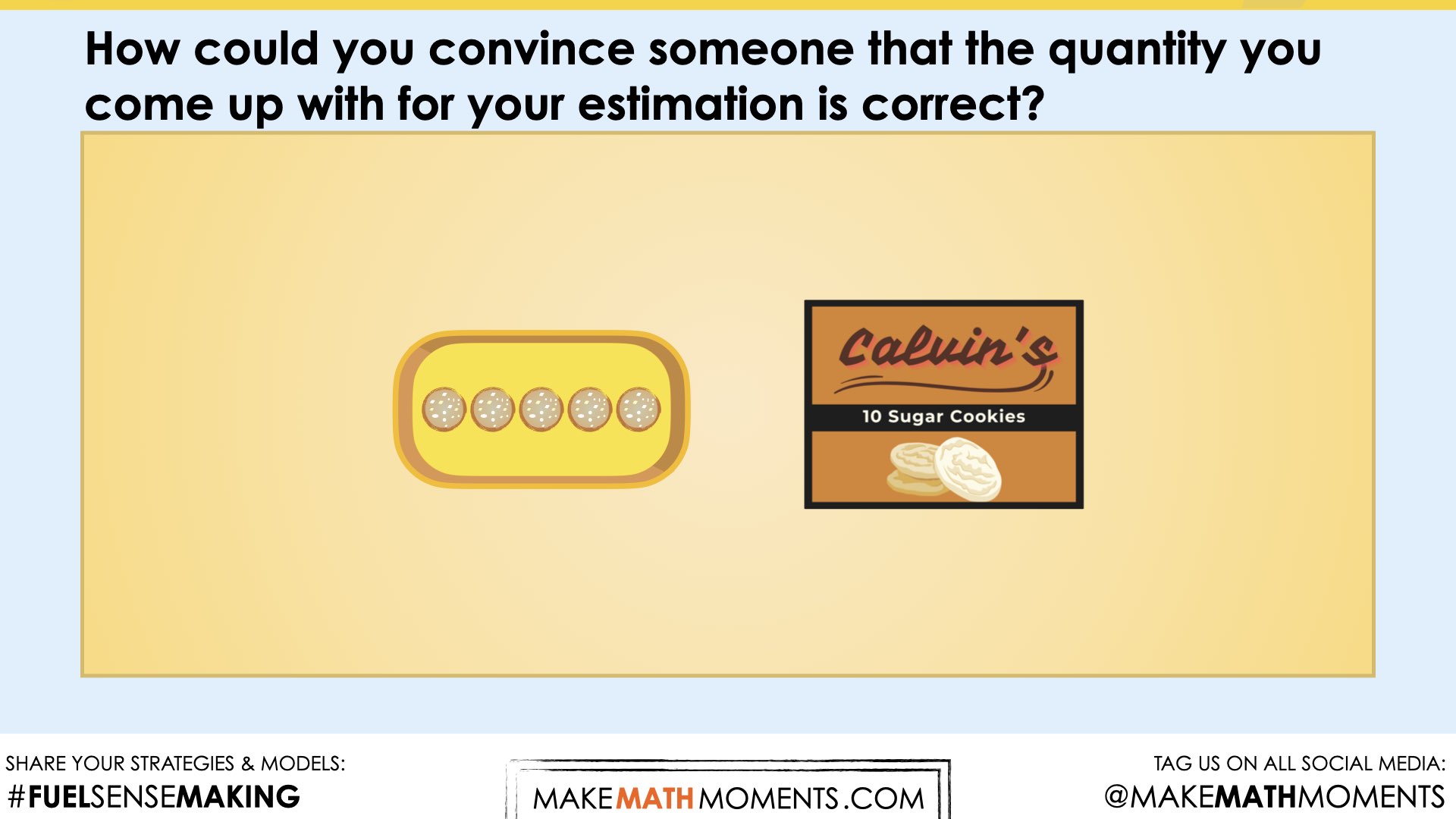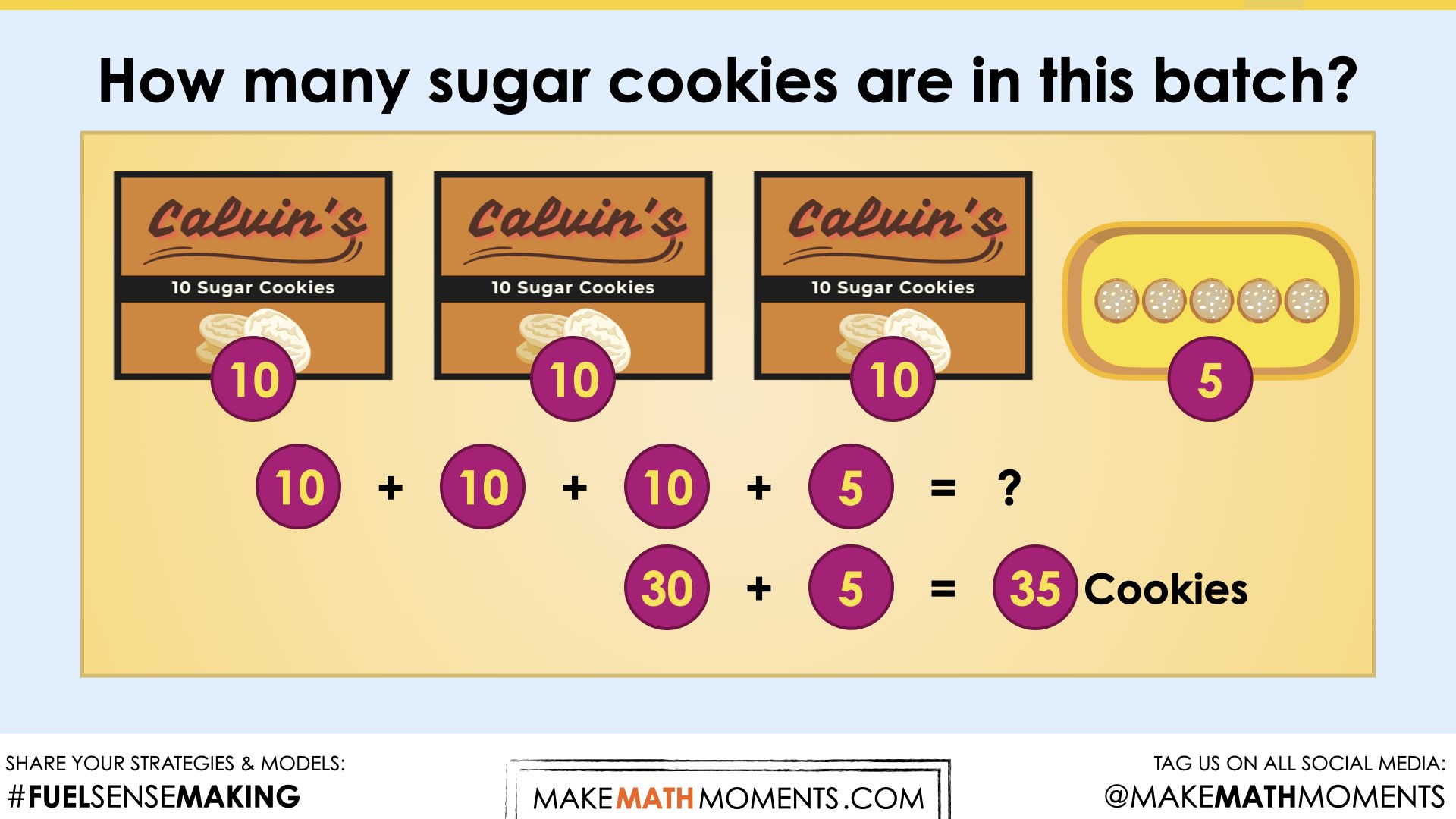CALVIN'S COOKIE COMPANY: BATCHES & BOXES [DAY 3]
DEVELOPING PLACE VALUE UNDERSTANDING
Bake in student understanding with this Unit of 3 Act Math Task lessons focused on developing place value understanding
Intentionality
Spark Curiosity
Fuel Sensemaking
During Moves
Student Approaches
Next Moves
Consolidation
Reflect and Consolidation Prompts
Resources & Downloads
Educator Discussion Area
Intentionality & Unit Overview

Length of Unit: 5 Days
Access each lesson from this unit using the navigation links below
Students will determine how many cookies are in a batch that has been organized into 3 boxes and 5 extras.
Some important vocabulary to use consistently throughout the unit:
Batch: The number of cookies made at one time. A batch of cookies is made from one or more baking sheets.
Baking sheet or sheet: Cookies are baked on sheets in random (non array) arrangements.
Boxes: Cookies are grouped by tens in boxes. All of the cookies in the box are the same flavor. These boxes are for sale to take out of the store.
Trays: Extra cookies are kept on trays. These single cookies are for sale in the store.
Intentionality…
Students will determine how many cookies are in a batch that has been organized into 3 boxes and 5 extras.
Some of the big ideas that may emerge through this task include:
- Unitizing (10 single cookies can be understood as 1 group of 10 cookies.)
- Place Value Number System (The two digits of a two-digit number represent amounts of tens and ones.)
- Properties of Addition [The commutative a+b=b+a and associative properties (a+b)+c=a+(b+c)]
- Equivalence [through composition and decomposition, a particular quantity can be represented in more than one way
(22 ones = 1 ten and 12 ones = 2 tens and 2 ones)
(22 cookies= 1 box and 12 loose cookies = 2 boxes and 2 loose cookies)].
Before starting this unit, students should be familiar with:
- Counting to 100 by ones and by tens.
- Writing numbers from 0 to 100.
- Understanding the relationship between numbers and quantities; connect counting to cardinality.
Spark Curiosity
What Do You Notice? What Do You Wonder?
Show students the following video:
Then, ask students:
What do you notice?
What do you wonder?

Give students about 30-60 seconds to do a rapid write on a piece of paper or silent individual think time.
Replaying the video can be helpful here if appropriate.
Then, ask students to pair share with their neighbours for another 60 seconds.
Finally, allow students to individually share with the entire group. Be sure to write down these noticings and wonderings on the blackboard/whiteboard, chart paper, or some other way that is visible to all. This helps students to see the thinking of their classmates and ensures each student that their voice is acknowledged and appreciated. Adding student names or initials next to their notice/wonder is one way to acknowledge their participation and can motivate others to join in.
Some noticings and wonderings that may come up:
- I noticed he baked sugar cookies.
- He must have taken a sheet out of the oven because then he was putting the cookies into boxes.
- Does Calvin make more than one kind of cookie?
- I wonder if he took more than one sheet out of the oven this time?
- The boxes look the same, so I think there must still be 10 cookies in each box.
- I wonder how many cookies he made in this batch.
- This time there were 5 extras.
- How many boxes did he fill?
- And many more.
At this point, you can answer any noticings and wonderings that you can cross off the list right away. Things like “Does Calvin make more than one kind of cookie?” (yes) can be addressed right away to show students that we are indeed listening to their contributions and that we value student voice.
Estimation: Prompt
After we have heard students and demonstrated that we value their voice, we can land on today’s question. Acknowledging that the question came from students underscores their identities as thinking mathematicians who are making sense of problems.


How many sugar cookies are in this batch?
Follow up that question with:
How could you convince someone that the quantity you come up with for your estimation is correct?
We can now ask students to make an estimate (not a guess) as we want them to be as strategic as they can possibly be. This will force them to think about place value (boxes and extras). The number of boxes isn’t clear which means they will also need to consider how many cookies could reasonably fit on a sheet. Before collecting student estimates, students can share their estimates in small groups along with a justification for the reasonableness of their prediction.
Consider asking students to think about a number that would be “too low” and a number that would be “too high” before asking for their best estimate in order to help them come up with a more reasonable estimate.
While Students are Estimating:
Monitor student thinking by circulating around the room and listening to the mathematical discourse. You may identify some students whose thinking would be valuable to share when the group’s estimates are collected.
Encourage students to use precise mathematical language (including tens, ones, extras, groups of ten, greater than, less than, more, less, half, higher than, lower than) to articulate their defense of their estimate. As well, now may be a good time to build up the vocabulary of this context: batch, baking sheet, box, tray.
Similar to collecting their noticings and wonderings, collect students’ range of estimates and/or best estimates along with initials or names. Having some students share justifications is an opportunity for rich, mathematical discourse.
At the end of this task, during The Reveal, revisit the estimates to see how accurate students were and to reflect on the assumptions they held and justifications they argued.
Fuel Sense-making
Crafting A Productive Struggle: Prompt

Since we’ve already invested time to set the context for this problem and student curiosity is already sparked, we have them in a perfect spot to help push their thinking further and fuel sense making.
Ask the students what information they will need and how they will use it in order to find out:
How many sugar cookies are in this batch?
Here we are asking students to envision a solution path. By considering what information will be needed and how it can be used to solve the problem, students are being asked to make sense of the problem and reason abstractly and quantitatively (Math Practices 1 and 2). By not simply providing this information, we are inducing students to engage more deeply with the problem and think about all of its parts, known and unknown, before they begin crunching the numbers.
After they have requested information and explained how they would use it to solve the problem, the following information can be provided.
- A screenshot of the 3 boxes and 5 extra cookies.
- An empty Calvin’s Sugar Cookies box with the label on the side clearly showing that it can hold 10 cookies. (The 10 cookie capacity was not visible in the video).
During Moves
While Students Are Productively Struggling…
Monitor student thinking by circulating around the room and listening to the mathematical discourse. At this time, teachers are looking for clear representations of student thinking to display later during the whole class discourse. In order to have a rich discussion later in the task, it is vital that teachers are intentional when they select a few work samples to share.
As students work to find out how many cookies there are all together in this batch, teachers can use some of their time to guide students who are struggling towards tools that might help them move forward towards a solution. Throughout this unit 10 frames and Base 10 notation{ ⎢ , ⌑ } might be tools that could help students with unitizing in groups of ten. However, during the majority of the student working time, it is essential for teachers to thoughtfully select some of the student solution strategies. After making a selection, ask a student from the group if they will be willing to present the group’s thinking during the whole class discourse.
Teachers should then sequence these work samples in a way that structures the discourse. Some possible ways to sequence the work samples include:
- Most accessible to least accessible solution strategies and representations.
- More common/frequent to less common/frequent strategies and representations.
- From concrete to pictorial to symbolic representations.
- Side by side simultaneous views that can highlight one key difference that is essential to finding a solution.
- Choose another approach to selecting and sequencing student work.
The tools and representations you might see students using to convince their peers and/or the teacher include:
- Using a tool to represent each group of 10 and the extras. The counting all by ones.
- Making 3 sets of 10 marks and 5 extras (ie: tallies, circles, exes, etc) and then counting all of them.
- Making 3 sets of 10 marks and 5 extras. Then circling groups of 10 cookies. Skip count 10, 20, 30. Then add on the final cookies one at a time ( 31, 32, 33, 34, 35).
- Using Base 10 block drawing to represent the cookies in groups of ten and some ones {⎢ , ⌑ }. Then add by counting the tens and then the ones.
- On an open number line add the tens (10, 20, 30). Then add on the final cookies one at a time (10, 20, 30, 31, 32, 33, 34, 35).
- Starting with the equation 10+10+10+5=?. Then adding 10+10+10=30. Then, combining the partial sums 30+5=35.
Student Approaches
Student Approach #1: Counting All with a Tool
Login/Join to access the entire Teacher Guide, downloadable slide decks and printable handouts for this lesson and all problem based units.
Student Approach #2: Counting All with a Drawing
Login/Join to access the entire Teacher Guide, downloadable slide decks and printable handouts for this lesson and all problem based units.
Student Approach #3: Grouping and Skip Counting/Repeated Addition
Login/Join to access the entire Teacher Guide, downloadable slide decks and printable handouts for this lesson and all problem based units.
Student Approach #4: Base 10 Block Drawing to Represent Skip Counting
Login/Join to access the entire Teacher Guide, downloadable slide decks and printable handouts for this lesson and all problem based units.
Student Approach #5: Equations to Represent a Represent Skip Counting or Adding by Place
Login/Join to access the entire Teacher Guide, downloadable slide decks and printable handouts for this lesson and all problem based units.
Student Approach #6: Equations to Represent a Represent Skip Counting or Adding by Place
Login/Join to access the entire Teacher Guide, downloadable slide decks and printable handouts for this lesson and all problem based units.
Next Moves
Reveal
Show students the following reveal video:


Consolidation
Login/Join to access the entire Teacher Guide, downloadable slide decks and printable handouts for this lesson and all problem based units.
Reflect and Consolidation Prompts
Reflect
After the reveal, check back to your estimations. The purpose here is to reflect on student reasoning, not on celebrating who was closest.
Were there some estimates in the right neighborhood?
What helped those students to get close?
How did they think about it?
Without a lot of information, mathematicians have to make assumptions all of the time. What assumptions made some estimates way too low or way too high?
Now that we have figured out how many cookies were in this batch, what new questions does this raise in your mind? You may choose to explore one or more of these student generated questions on another day or as homework.
Consolidate:
Provide students an opportunity to reflect on their learning by offering these consolidation prompts to be completed independently.
Consolidation Prompt #1:
Login/Join to access the entire Teacher Guide, downloadable slide decks and printable handouts for this lesson and all problem based units.
Consolidation Prompt #2:
Login/Join to access the entire Teacher Guide, downloadable slide decks and printable handouts for this lesson and all problem based units.
Consolidation Prompt #3:
Login/Join to access the entire Teacher Guide, downloadable slide decks and printable handouts for this lesson and all problem based units.
Consolidation Prompt #4:
Login/Join to access the entire Teacher Guide, downloadable slide decks and printable handouts for this lesson and all problem based units.
We suggest collecting this reflection as an additional opportunity to engage in the formative assessment process to inform next steps for individual students as well as how the whole class will proceed.
Resources & Downloads
Login/Join to access the entire Visual Prompt, downloadable slide decks and printable handouts for this lesson and all problem based units.
Printable Lesson Plan PDF
Videos, Images & Media Files
Apple Keynote Presentation
Powerpoint Presentation
Printable Consolidation Prompts
Educator Discussion Area
Login/Join to access the entire Teacher Guide, downloadable slide decks and printable handouts for this lesson and all problem based units.
Explore Our 60+ Problem Based Units
This Make Math Moments Lesson was designed to spark curiosity for a multi-day unit of study with built in purposeful practice, number talks and extensions to elicit and emerge strategies and mathematical models.
Dig into our other units of study and view by concept continuum, grade or topic!


